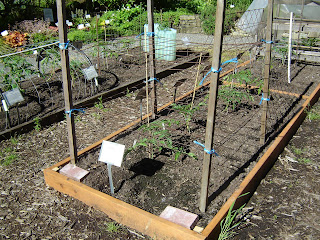Last weekend I paid a visit to the Bellevue Demo Garden to learn how to thin apple trees and protect them from Apple Maggot Flies and Coddling Moth.
Larry Davis was my tutor..... a member of the Fruit Tree Society he really knows his stuff and quickly got me up and running on how it's all done. There are a number of apple trees at the demonstration garden, two of them espaliers, two columnar and one in the traditional form.
First thing to do is find a cluster of set fruit. Ideally the fruit should be about the size of the top of your finger, but you can do the thinning and put the booties on if the fruit are a little smaller, like the ones shown below.

With your cluster identified, take a look at each fruit and identify the most vigorous fruit of the bunch (this is called the King fruit). It'll be the one with the thickest stem. When you find it, trim off all the others. Yes, that seems like a total waste doesn't it? I thought the same thing, but Larry assured me that it's better to do this than the alternative. The fruit that remains after your thinning won't have to compete for resources, so will have every opportunity to attain its full potential. Studies have shown a domesticated tree's productive yield is higher for trees that are thinned than from those that are not, and trees that are not thinned will, year-over-year, set less fruit as it weakens from the extended demands..... so don't chicken out.... prune them out!
Now it's time to put the booties on. Larry handed me a plastic bag full of what looked like tiny panty hose! Hilarious!
Actually, these Maggot Barriers are specifically made for the task - you can buy them online from any reputable gardening resource, like Territorial Seed for example.
The barriers are small, tube-like lengths of hose, sewn closed at one end. Each one, when stretched out lengthwise is about 8"-10" long.......
.........and when stretched out wide can cover an object about the size of a tennis ball. If you have old panty hose lying around you can recycle them - just cut them up into lengths and tie a knot in one end - one less thing going into a landfill (thank you, thank you!), but I doubt you'll have enough old panty-hose to support the task, so be prepared to go buy a bag of the booties.
With a bootie in hand, stretch it lengthwise and widthwise to open it up, and then place it over the singled out fruit, leaving about half of the tube extending out past the fruit (to accommodate the fruit as it grows). With the fruit covered, pinch your fingers around the base of the fruit and with your other hand, twist the remaining end of hose into a rope-like strand and carefully wrap it around the stem of the branch without mangling any leaves in the process. This will hopefully keep it secure if it gets windy, or a bird or other critter comes along and tries to investigate.
That's it! Rinse and repeat for however many clusters of fruit you have on your tree.
Ideally your bootied fruit should be about 6" apart or greater, so each fruit gets maximum exposure. If you have a few clusters growing close really together you'll need to decide which one to sacrifice (which in this case means pruning off ALL the fruit in the cluster). Take into consideration the size of the mature fruit.... you may be able to cut that 6" distance down a little bit if you've got a species of Apple that's small.
Keep in mind you may not be able to complete your thinning/booting all in one day because:
a) it's a time consuming task and you may have a heavily laden tree, or multiple trees to manage
b) some fruit clusters may not be ready (big enough) to thin, so you'll have to come back each week for a few weeks and repeat the process until all the clusters have set.
Here's an idea...... if you've got a gardening friend who also has Apple trees, maybe you can offer to help them do theirs if they come and help you do yours. Having a friend to natter with while you get the job done will make it more fun, and the job will get done more quickly.
Larry said booties aren't necessary for Pear trees so just go at it for your Apples, then sit back and look forward to your bounteous harvest next Fall.
Now you could abandon the idea of doing the bootie bit and once you've done your thinning go the chemical route to protect your crop, but I strongly recommend you avoid that. You'll miss a golden opportunity to brag about how you're implementing an Integrated Pest Management plan in your garden, and you'll be able to go to sleep at night proudly knowing you were a little kinder to our planet. Thank you!

























